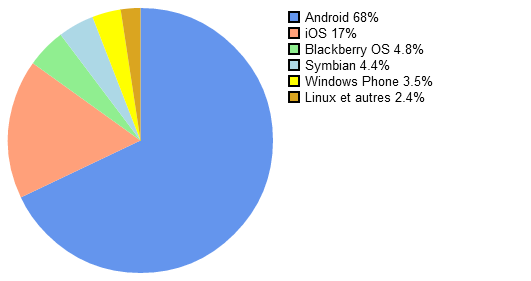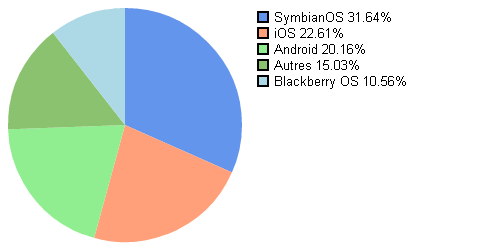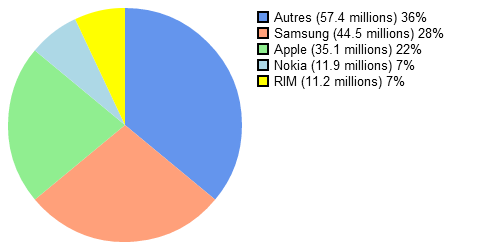What has been the evolution of the two companies, leaders in their market, face an entirely new product?
With the emergence of this product, the reaction has not been quite the same. RIM, maker of the Blackberry range popular in business, we had fun dealing with this toy for children. At Nokia we are a little crestfallen because the company itself had designed similar prototypes and did not want to exploit them. But the iPhone is an expensive product while Nokia provides cheap devices to the masses, it was not more worried in the Finnish company in the Canadian business.
The fact is that sales in both cases have continued to progress after the appearance of the iPhone in June 2007, until 2010. Since 2010 it is a different story. What is not included in the managements of the two companies is that user habits would change, he would find a substitute in smartphones to computers for some common applications, messaging, above all, and therefore that these devices would replace traditional mobile, whether in business or in everyday use.
Evolution of Nokia and Blackberry from iPhone
These figures relate to the US, but reflect the global status
Nokia with Windows Phone is different
Until 2007, the Symbian system used by Nokia (and redeemed to a third company, it is important to emphasize), represented more than 60% of global market share. Note that the chart above concerns the USA. Nokia continued to have growth in the field of smartphones, like the Blackberry, but less than Apple. Only with the growing success of Android and Samsung in 2010, Nokia's fall has begun. In response, the firm estimated its home system, MeeGo, Linux-based Qt, was not yet ripe and prefer to upgrade to Windows Phone. Another solution would be to adopt Android and so dispose from the outset of a quantity of applications, but the company wanted to differentiate. It is also possible that the new CEO, Stephen Elop came from Microsoft, has a skewed vision.
This has not been a great success since the market share and the share price had been falling until the redemption of the Microsoft announced in 2013. And the return of Stephen Elop from Microsoft!
Blackberry differs with QNX
Blackberry placed all his hopes on the Z10, a smartphone based on the QNX system renowned Blackberry OS. This has been a resounding failure and a loss of $ 900 million of unsold stocks.
Like Nokia, RIM, also famous Blackberry - the name does not really happy - would be different with its own OS. So she bought QNX in 2010, an interesting system in its distributed design, but not designed for smartphones. The conversion of the system and Java-based software on this system is more difficult and time than expected. Products, namely the Playbook and the Z10 is not aboutis. The tablet has no voicemail although it is the first service offered by the old Blackberry smartphones.
It is clear that in trying to differentiate themselves, the manufacturer has accumulated handicaps - very few applications, a system not to the point - without adding anything more to attract consumers.
To show how leaders are out of touch with consumers, the founder and CEO (until 2012) Mike Lazardis, thought to rebound, the company had to cease production of wide-screen smartphones, arguing that the company knew doing so best was moving to physical keyboard!
The principle of differentiation in question
Facing the same problem, do not have a smartphone OS for touch, the two companies have reacted the same way. She refused to adopt Android, an OS ready to use and free to not be seen as another mobile maker touchscreen using Android, and preferred to use a particular OS to differentiate.
This principle applies as the OS "different" is superior to the common OS, but as this is not really the case, it is even worse in the case of QNX as less suited to the function, I do not understand not too the principle of differentiation. Do you want to be different just to hide the fact that we are not better products than others?
Because users when with them, do not ask this difference. The proof is that Samsung, which copies without restraint Apple products is currently the market leader.
I think users want rather something he know the iOS or Android system, and especially the applications running on these systems, rather than a new system x, y or z unfamiliar.
Paid manufacturer to offer more features. Nokia has shown us that she was able to bring the material these functions and more, for example with wireless charging and premium video.
Epilogue
We know what happened to the two companies. Blackberry increased from 47% to 2% of market share. His last hope, based on QNX Blackberry 10 is a total failure. The company withdrew from the consumer market and offered for sale.
As for Nokia, which in seen in Windows Phone and an alliance with Microsoft, a way to bounce back after a descent into hell like it got rid of its mobile business from Microsoft.
But this is not the iPhone that killed the two companies, as shown in the graph. Rather all mobile touchscreen, so Samsung, Sony and all the others, rather than Apple. One might think that if the two companies had adopted Android and that they were differentiated from its services to companies, the other is not its hardware, they could maintain a significant market share, but we will know never with certainty. A requiem has already sung for these two losers. The choice of statistical operations of mobile phone systems in the world in February 2012.
The choice of statistical operations of mobile phone systems in the world in February 2012.





